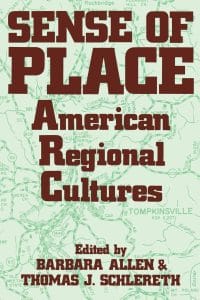NOTE: THIS WEBSITE IS A WORK IN PROGRESS. RESOURCES AND DATA ARE ADDED DAILY.
IMPORTANT: We are in urgent need of funding to keep this project alive and ensure its future. If you’re enjoying the site and see our vision for the project, please consider joining as a paid member or contributing to our crowdfunding campaign today. It is only with your help that we can continue this work.
Thanks so much for your support! – Jes
![]()
Sense of Place: American Regional Cultures
share:
Some buttons on this page link to external websites. If you visit one of our affiliate sites and make a purchase, I may receive a small commission at no extra cost to you. More info
- UPDATED: 6.29.2025
- Regional, Culture
editor:
Barbara Allen, Thomas J. Schelereth
publisher:
date:
10.23.1992
ISBN:
9780813108179
pages:
224
notes:
contents:
description:
The authors range widely over the United States, from the Eastern Shore to the Pacific Northwest, from the Southern Mountains to the Great Plains. They look at a variety of cultural expressions and practices—legends, anecdotes, songs, foodways, architecture, and crafts. Tying their work together is a common consideration of how regional culture shapes and is shaped by the consciousness of living in a special place. In exploring this dimension of regional culture the authors consider the influence of natural environment and historical experience on the development of regional culture, the role of ethnicity in regional consciousness, the tensions between insiders and outsiders that stem from a sense of regional identity, and the changes in culture in response to social and economic change.
With its focus on cultural manifestations and its folkloristic perspective this book provides a fresh and needed contribution to regional studies. Written in a clear, readable style, it will appeal to general readers interested in American regions and their cultures. At the same time the research and analytical approach make it useful not only to folklorists but to cultural geographers, anthropologists, and other scholars of regional studies.
CMOS:
author-date:

